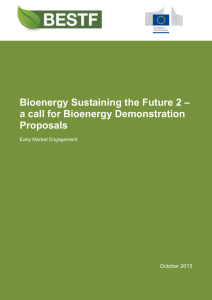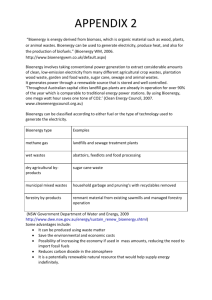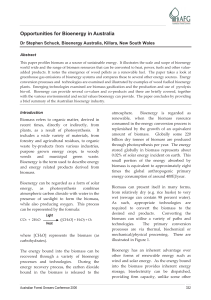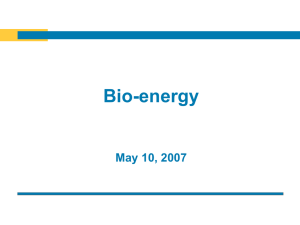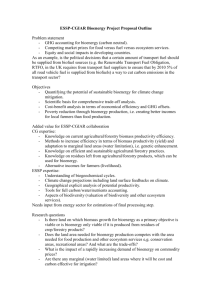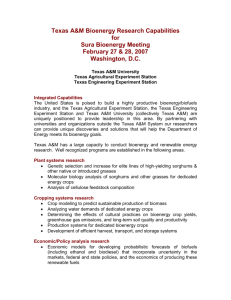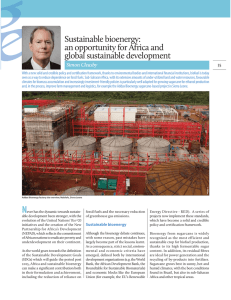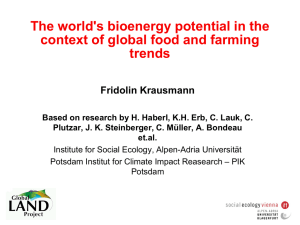PowerPoint
advertisement
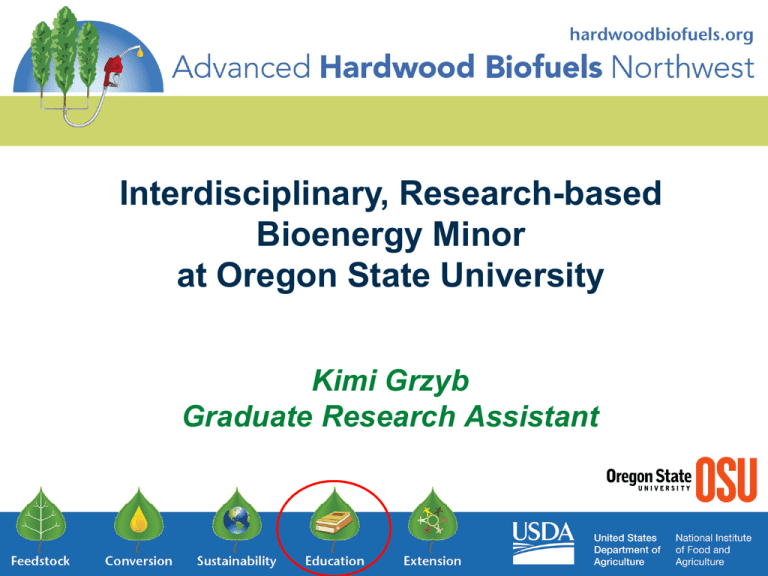
Interdisciplinary, Research-based Bioenergy Minor at Oregon State University Kimi Grzyb Graduate Research Assistant Our goal is to produce: Broadly-trained graduates capable of cross-disciplinary problem solving and innovation to meet current and future needs of biofuels, bioproducts, renewable energy and related industries hardwoodbiofuels.org Bioenergy Minor Overview • Interdisciplinary Open to students from any major • 2 New Courses + existing courses Why a minor? • Speed and ease of implementation • Can be added to any major: breadth (minor) and depth (major + research project) hardwoodbiofuels.org Bioenergy Minor Requirements (29 credits) • 1st-year core: • Introduction to Regional Bioenergy (BRR 350; Fall, 2 credits) • Interdisciplinary Research: Bioenergy Focus (BRR 450; Winter, 2 credits) • Bioenergy and Environmental Impacts (WSE 473; Spring, 3 credits) • Electives from 3 categories (2-4 credits each): • Technical • Environmental • Social/Economic/Policy • • • • Research (10 credits) with a mentor Data Presentation (1 credit) Thesis (3 credits) Public Seminar (1 credit) hardwoodbiofuels.org Bioenergy Minor students will be able to: 1. Demonstrate an understanding of the core concepts of bioenergy, present and discuss important contemporary issues and challenges related to bioenergy, and suggest multidisciplinary approaches to solving bioenergy problems. BRR 350 2. Explain the research process, including quantitative and qualitative research methods and the use of evidence. BRR 450 3. Design a bioenergy research project, collect and analyze data, and interpret results. RESEARCH 4. Competently convey the meaning of research results in written and oral format, and demonstrate the ability to communicate with professionals, policymakers, and the general public. THESIS, POSTER, SEMINAR hardwoodbiofuels.org Course Highlights • • • • • • Cross-disciplinary Team Projects Proposal Writing Lectures by Researchers/Experts Current Events Library Workshop Field Trips and Lab Tours • Pacific Biodiesel • Greenwood Resources • Corvallis Wastewater Treatment Plant • Coffin Butte Landfill • Stahlbush Farms • Strauss Transgenic Poplar Lab • Liu Microbial Fuel Cell Lab Research Component “An inquiry or investigation conducted by an undergraduate that makes an original intellectual or creative contribution to the discipline” (Hu et.al., 2008, p.6) Involves: • Reading appropriate literature • Asking a researchable question • Designing some part of the project • Using reproducible research techniques • Communicating significant findings orally and/or in writing Student Gains: • Increased self-efficacy • Ability to work both independently and as part of a team • Critical thinking and problem solving • Professional skills: project management, organization, communication, networking, and using technology • Clarification of and enhanced preparation for career and/or graduate school goals Examples of Undergraduate Research Projects Shanti Johnson, Chemical Engineering Research: Investigating ways to lower the cloud point of biodiesel so it can be used at lower temperatures without gelling Crystal Oldfield, BioResource Research Research: Extracting tannins & lignin from pecan shells EXAMPLE SKILLS GAINED: • MATLAB algorithm development • Electron Microscope training Incentives Students: • Scholarships ($1000-4000/year) • Internship funding (up to $4000 total) Research Mentors: • $1000 per student per year to help offset the cost of research Students • 2012-2013 cohort: 10 (2 graduated) • 2013-2014 cohort: 10 • 2014-2015 cohort: 10 MAJORS: • Biochemistry and Biophysics • Bioengineering • Chemical Engineering • Ecological Engineering • Renewable Materials • Microbiology hardwoodbiofuels.org • • • • • • • Applied Economics Political Science BioResource Research Horticulture Botany Sociology Management Assessment • Ongoing, formative – enables us to modify/improve program • Pre/Post surveys Based on specific learning objectives Self-report slider scales and open-ended prompts hardwoodbiofuels.org Findings • Ratings: Sample size too small • Open-ended: Example - Describe three strengths of the Bioenergy minor program Common Themes: - Interdisciplinary nature - Research experience - Flexible; students can tailor the program to suit their interests hardwoodbiofuels.org Challenges • Recruitment – New minor, Bioenergy is relatively unknown New Adviser - Advertising through other advisers • Scheduling classes – Time conflicts with multiple majors New courses taught from 6-7:50 PM once a week • Research – Time-consuming, student perceptions/fear, matching students with mentors Highlight benefits: networking, soft skills, grad school Existing BioResource Research program as model hardwoodbiofuels.org Ongoing Work and Future Plans • • Convert current classes to Ecampus (BRR 350 complete) • • • Assessment: Continue surveys, provide feedback Delphi study: Survey experts on essential concepts for Bioenergy education; compare input from industry and academia and strengthen program based on employer needs Articulation: Meetings with community colleges Continuation of program: Identifying options after grant funding ends hardwoodbiofuels.org Thank you! We are grateful for funding from USDA-NIFA: Regional Approaches to Sustainable Bioenergy Regional Coordinated Agricultural Project (CAP) • http://agsci.oregonstate.edu/bioenergy/bioenergyminor • Director: kate.field@oregonstate.edu hardwoodbiofuels.org
